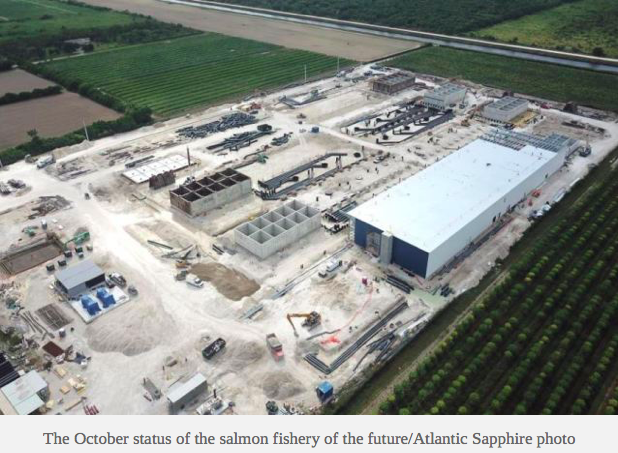By CRAIG MEDRED
CRAIGMEDRED.NEWS
While fisheries biologists in the north are hard at work crunching numbers in an effort to develop their best guess at how many salmon will return to Alaska next year, Atlantic Sapphire is getting ready to load it first 800,000 salmon eggs into a massive, onshore “Bluehouse” in Florida.
A “successful 90-day, on site hatchery trial has validated water quality and local conditions,” the Norwegian company said in a report to shareholders in mid-November.
The company is expecting to be producing 10,000 tons of salmon annually by the second quarter of 2020, and envisions eventual expansion to 90,000 tons per year.
The implications for Alaska commercial salmon fisheries are significant, but those who suggest the growing competition warrants some serious discussion as to how the 49th state retains value in its salmon resources are generally vilified as commercial fishery haters.
Alaskans like to believe their wild salmon are easily marketable as superior to those raised on farms, but it was farmed salmon that led a big boom in sales in Japan – home to some discerning fish consumers – because the farmed fish were safer to eat.
“To capitalize on salmon’s popularity, efforts to culture the fish are (now) starting in various parts of Japan,” NHK Newsline from Tokyo reported in October. “In August, Kotoura Town in Tottori Prefecture started shipping silver salmon grown at an onshore facility.”
Japanese onshore production is so far small, but the 90,000 tons Atlantic Sapphire plans is massive.
“Between 1978 and 2003, the Bristol Bay sockeye harvest averaged 62,000 metric tons (mt), and ranged from a low of 26,000 mt to a high of 110,000 mt,” according to a report written by Alaska fisheries economist Gunnar Knapp, who first started warning about the farmed fish challenge to Alaska salmon more than a decade ago.
“In 1980, total world salmon supply was less than 550,000 tons, of which 98 percent was wild,” he wrote in a 2004 report. “By 2001 world supply had more than quadrupled to more than 2.2 million tons, 62 percent of which was farmed.”
[Read more at CraigMedred.news]

Pick the color palette like your dutch boy paint! Fish grown and soaked in its own exrement! Fed a diet of … What??? Transferring diseases to wild salmon like a night clubbing in the 80’s! Behold the FRANKENFISH!
Trying to figure out what the story is supposed to show. 10k tons of farmed salmon is .5% of the current world production. Alaska wild salmon will always have a place in the market. Craig Medford is simply pounding his laptop in some back room pretending to be a news person. He has been a commercial fisheries hater for at least 35 years. Just go read any 5 stories he has written when fisheries are mentioned and a blind person can see the anti commercial fishermen slant. It’s not like he has a real job writing for anyone
Amen!
Comments are closed.